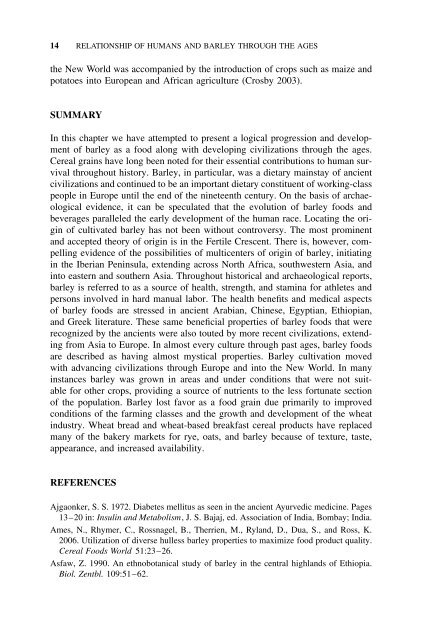Barley for Food and Health: Science, Technology, and Products
Barley for Food and Health: Science, Technology, and Products
Barley for Food and Health: Science, Technology, and Products
Create successful ePaper yourself
Turn your PDF publications into a flip-book with our unique Google optimized e-Paper software.
14 RELATIONSHIP OF HUMANS AND BARLEY THROUGH THE AGES<br />
the New World was accompanied by the introduction of crops such as maize <strong>and</strong><br />
potatoes into European <strong>and</strong> African agriculture (Crosby 2003).<br />
SUMMARY<br />
In this chapter we have attempted to present a logical progression <strong>and</strong> development<br />
of barley as a food along with developing civilizations through the ages.<br />
Cereal grains have long been noted <strong>for</strong> their essential contributions to human survival<br />
throughout history. <strong>Barley</strong>, in particular, was a dietary mainstay of ancient<br />
civilizations <strong>and</strong> continued to be an important dietary constituent of working-class<br />
people in Europe until the end of the nineteenth century. On the basis of archaeological<br />
evidence, it can be speculated that the evolution of barley foods <strong>and</strong><br />
beverages paralleled the early development of the human race. Locating the origin<br />
of cultivated barley has not been without controversy. The most prominent<br />
<strong>and</strong> accepted theory of origin is in the Fertile Crescent. There is, however, compelling<br />
evidence of the possibilities of multicenters of origin of barley, initiating<br />
in the Iberian Peninsula, extending across North Africa, southwestern Asia, <strong>and</strong><br />
into eastern <strong>and</strong> southern Asia. Throughout historical <strong>and</strong> archaeological reports,<br />
barley is referred to as a source of health, strength, <strong>and</strong> stamina <strong>for</strong> athletes <strong>and</strong><br />
persons involved in hard manual labor. The health benefits <strong>and</strong> medical aspects<br />
of barley foods are stressed in ancient Arabian, Chinese, Egyptian, Ethiopian,<br />
<strong>and</strong> Greek literature. These same beneficial properties of barley foods that were<br />
recognized by the ancients were also touted by more recent civilizations, extending<br />
from Asia to Europe. In almost every culture through past ages, barley foods<br />
are described as having almost mystical properties. <strong>Barley</strong> cultivation moved<br />
with advancing civilizations through Europe <strong>and</strong> into the New World. In many<br />
instances barley was grown in areas <strong>and</strong> under conditions that were not suitable<br />
<strong>for</strong> other crops, providing a source of nutrients to the less <strong>for</strong>tunate section<br />
of the population. <strong>Barley</strong> lost favor as a food grain due primarily to improved<br />
conditions of the farming classes <strong>and</strong> the growth <strong>and</strong> development of the wheat<br />
industry. Wheat bread <strong>and</strong> wheat-based breakfast cereal products have replaced<br />
many of the bakery markets <strong>for</strong> rye, oats, <strong>and</strong> barley because of texture, taste,<br />
appearance, <strong>and</strong> increased availability.<br />
REFERENCES<br />
Ajgaonker, S. S. 1972. Diabetes mellitus as seen in the ancient Ayurvedic medicine. Pages<br />
13–20 in: Insulin <strong>and</strong> Metabolism, J. S. Bajaj, ed. Association of India, Bombay; India.<br />
Ames, N., Rhymer, C., Rossnagel, B., Therrien, M., Ryl<strong>and</strong>, D., Dua, S., <strong>and</strong> Ross, K.<br />
2006. Utilization of diverse hulless barley properties to maximize food product quality.<br />
Cereal <strong>Food</strong>s World 51:23–26.<br />
Asfaw, Z. 1990. An ethnobotanical study of barley in the central highl<strong>and</strong>s of Ethiopia.<br />
Biol. Zentbl. 109:51–62.

















